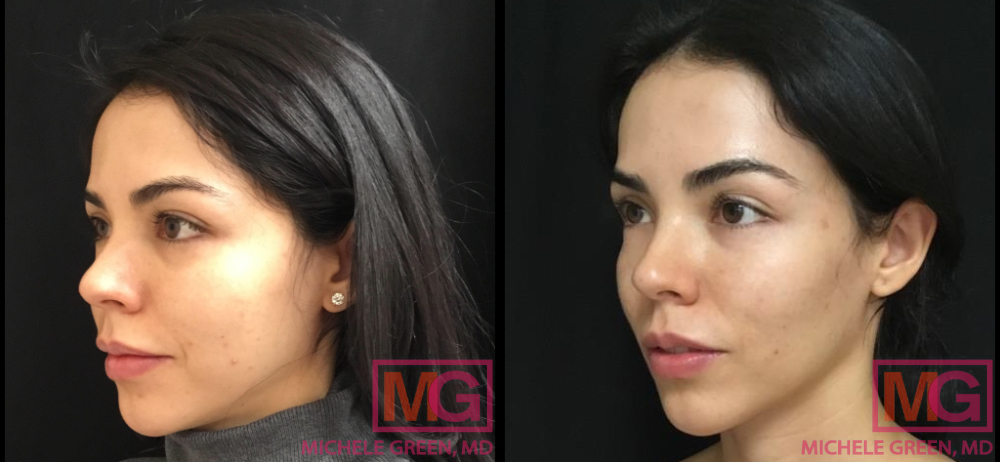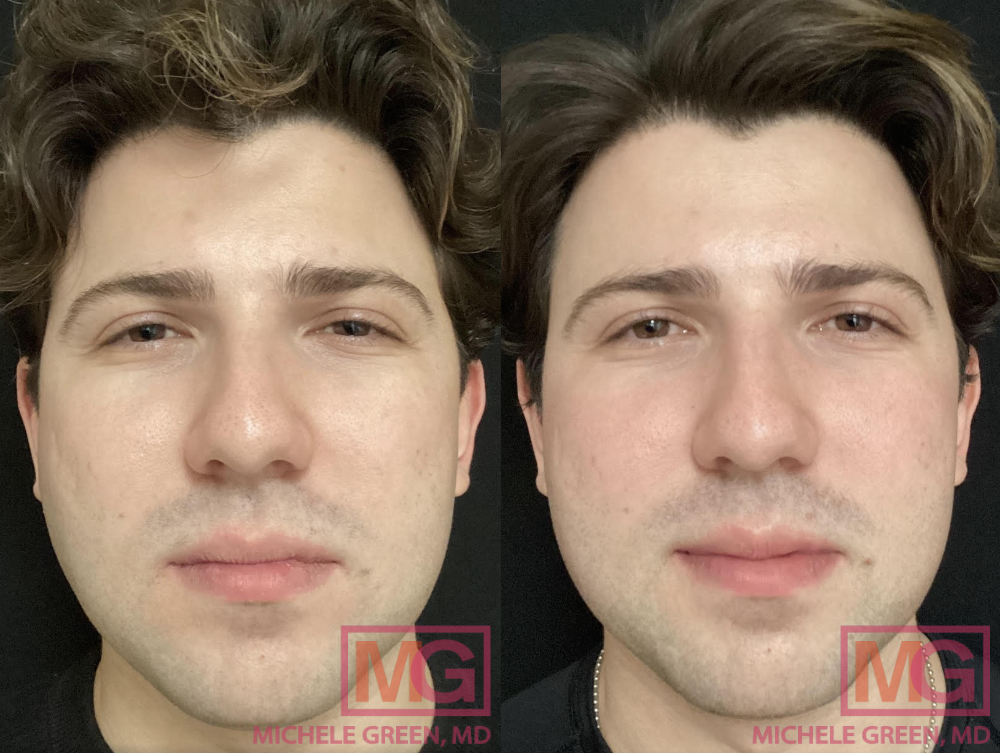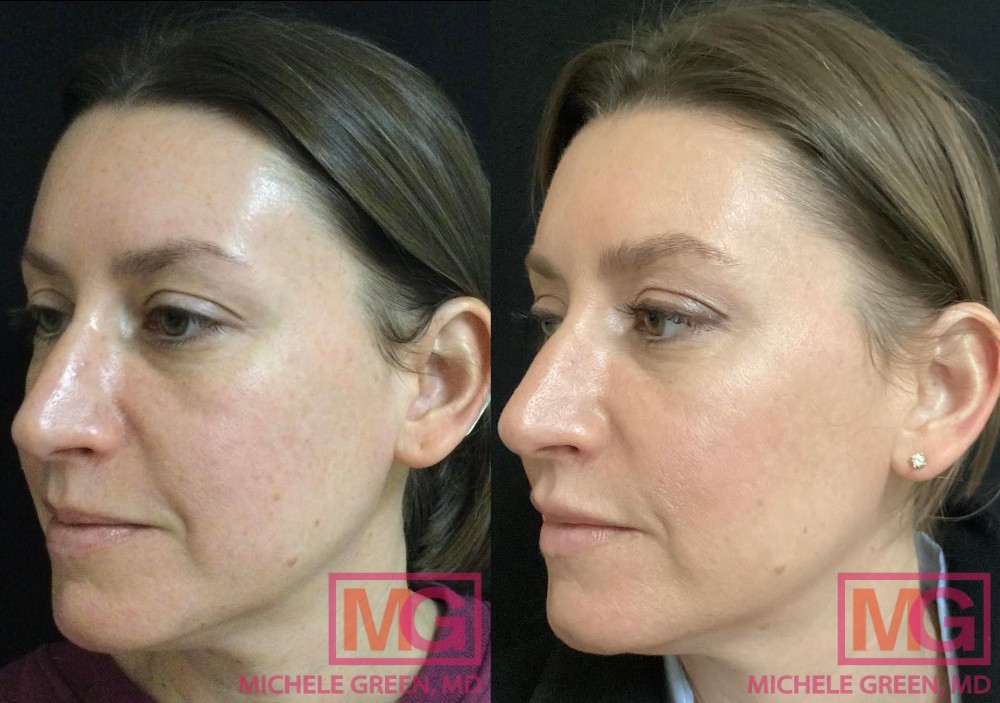What is the best cheek filler?
Cheek fillers are non-invasive dermal filler injections used for cheek and facial rejuvenation. When injected into the midface, cheek fillers can help to replenish lost volume due to natural aging, smooth out the appearance of fine lines and wrinkles, enhance the definition of bone structure, and increase collagen production. Collagen is a protein essential for providing structure and a firm foundation to the skin for a youthful appearance. As we age, collagen production decreases, and the loss of volume can result in the appearance of tired-looking, sunken cheeks. Luckily, natural-looking, voluminous cheeks can be achieved without the need for invasive cosmetic surgery thanks to the development of injectable fillers. Cheek filler treatment is one of the most popular facial augmentation procedures in Dr. Michele Green’s private NYC office due to its safety and efficacy for cheek enhancement with little to no downtime or side effects.
There are many different types of cheek fillers, including hyaluronic acid fillers such as Juvederm Voluma and Restylane Lyft, and semi-permanent fillers such as Radiesse and Sculptra. These fillers are long-lasting and contain little to no downtime and side effects. Each filler contains a unique formulation to address various skin concerns and aesthetic goals. Some fillers provide a more dramatic, voluminous effect, while others provide subtle, natural-looking rejuvenation. There is no one answer to which cheek filler is best, as it will depend on an individual’s unique facial anatomy and the type of results they are looking for. Whether it’s restoring lost volume or enhancing cheekbone structure, Dr. Green will work with you to choose the best cheek filler for your individualized skin concerns.
Dr. Michele Green is an internationally renowned board-certified dermatologist with over 25 years of experience treating her patients with non-invasive cosmetic procedures such as cheek fillers, under-eye or tear trough fillers, Botox, and more. She has consistently been voted as a top NYC dermatologist by Castle Connolly, New York Magazine, Super Doctors, and The New York Times due to her accessibility and dedication to her patients. Well-known for her dermal filler artistry, Dr. Green is an expert at choosing the best cheek filler available for each individual patient to tailor their treatment plan to their ideal facial rejuvenation goals. With Dr. Green, you will be able to achieve a natural, more youthful-looking appearance with results that last.

What are cheek fillers?
Cheek fillers fall under the umbrella term of dermal fillers, which are FDA-approved liquid or gel-like substances that are injected into soft tissues to replenish volume loss, reduce fine lines and wrinkles, improve acne scars, and enhance certain facial features. Cheek fillers are dermal fillers specifically formulated to be injected into the cheeks and midface. While there are many different types of fillers on the market, the most popular cheek fillers are made of hyaluronic acid, poly-L-lactic acid, or calcium hydroxylapatite. Hyaluronic acid (HA) is a naturally occurring substance in the body that provides essential hydration to the skin for plumpness and smoothness. Poly-L-lactic acid and calcium hydroxylapatite are two compounds that work to stimulate new collagen production once injected to produce a smoother skin texture and restore volume to the treated area. Once injected, cheek fillers provide long-lasting results that can hold anywhere between nine months to two and a half years, depending on the filler used.
Which filler is best for cheeks?
Dr. Green uses several types of fillers for the cheek areas. There is no one answer as to which filler is best for cheeks, as each filler contains different properties and formulations to address various skin needs. Dr. Green will consider each patient’s unique concerns and aesthetic goals to choose the best cheek filler that will provide them with their desired results. The most popular cheek fillers on the market include Juvederm Voluma XC, Radiesse, Restylane Contour, Restylane Lyft, and Sculptra.
Juvederm Voluma XC is an FDA-approved hyaluronic acid filler for treating volume loss and fine lines in the midface. It is made with hyaluronic acid that immediately plumps the skin and smooths out lines and wrinkles. Its patented Vycross technology results in reduced swelling and long-lasting results for up to one year. In addition to cheek augmentation, Juvederm Voluma is commonly used in the chin and jawline for facial rejuvenation.
Radiesse is a dermal filler formulated with calcium hydroxyapatite (CaHA) microspheres. When injected, these microspheres form a scaffolding under the skin for collagen production to occur. While the thick, gel-like consistency of Radiesse allows for immediately visible results, collagen production will continue to occur as the gel is absorbed, allowing for natural-looking results to last for up to two years. Radiesse is FDA-approved for correcting moderate to severe facial folds and wrinkles in the cheeks as well as the nasolabial folds.
Restylane Lyft is a hyaluronic acid-based dermal filler that is FDA-approved to restore age-related volume loss in the midface. As its formulation is the thickest hyaluronic acid-based dermal filler in the Restylane Family, Restylane Lyft is often used to enhance bone structure and provide a lifting effect in the cheek area. It can also be used to reduce fine lines in the lower face and enhance the chin and jawline.
Restylane Contour is a newer addition to the Restylane dermal filler product line and is FDA-approved for cheek augmentation. Restylane Contour is a hyaluronic acid-based filler that is formulated with proprietary XpresHAn technology, allowing for flexibility and dynamic movement in the cheek area and midface once injected. Restylane Contour is long-lasting and has been shown to last for up to 18 months when injected into the cheeks.
Sculptra is a unique facial filler used to treat volume loss and correct facial contour deficiencies and wrinkles. Sculptra is comprised of poly-L-lactic acid (PLLA), which stimulates the body’s own collagen production once injected. Natural collagen synthesis will continue to occur long after the product is broken down, allowing for results to last for two years or more after treatment. Sculptra injections provide gradual results and typically require a series of three or more treatments to achieve desired results. Sculptra is FDA-approved for treating facial wrinkles, smile lines, marionette lines, and volume loss in the cheeks but is commonly used off-label for non-surgical body contouring in areas such as the hips and buttocks.

Which cheek filler lasts the longest?
Sculptra and Radiesse are the longest-lasting cheek fillers, as results can last for two years or more after the series of treatments are completed. HA fillers such as Juvederm Voluma, Restylane Lyft, and Restylane Contour typically last for nine to twelve months, depending on the exact filler used. Dr. Green recommends engaging in annual treatment sessions to maintain and enhance your desired cosmetic results.
Where should cheek fillers be placed/injected?
Cheek filler is typically injected around and above the cheekbones. Cheek fillers can also be injected lateral to the smile lines into the middle cheek region, depending on your exact facial anatomy. For women, cheek filler is often injected into targeted areas to enhance the angle of the “Ogee Curve,” or the S-shaped curve seen when an individual’s face is slightly turned on its side. This curve typically depresses with age-related volume loss. For men, cheek filler is often injected to project the appearance of the zygomatic arch and enhance the structure of the cheekbone. During your initial consultation with Dr. Green, she will assess your unique facial anatomy to determine where best to inject your cheek filler.
What are the side effects of cheek fillers?
There are minimal side effects associated with cheek fillers. Before your procedure, a numbing cream containing lidocaine is applied to the cheek area to minimize any discomfort or pain. After treatment, patients may experience mild swelling, redness, or bruising around the injection sites – these effects are temporary and will resolve independently. If pain occurs, Dr. Green always advises her patients to take Tylenol instead of NSAIDs like Advil, Motrin, or Ibuprofen, as they can lead to an increased risk of bruising. Additionally, patients prone to bruising are advised to take oral or topical Arnika Forte, an herbal supplement that helps to prevent and reduce bruising. Allergic reactions to cheek fillers are very rare but can include asymmetrical fullness, persistent swelling or tenderness, or nodule formation.
Can cheek fillers move?
Cheek filler migration is a rare side effect where the dermal filler moves from the injected area in the cheeks to other areas of the face. Cheek filler migration can result in an asymmetrical or uneven appearance. Cheek fillers typically do not move, especially when injected by a certified plastic surgeon or dermatologist such as Dr. Michele Green. Dr. Green has been using dermal fillers for facial rejuvenation for over 25 years and will inject the appropriate amount of filler into the treatment area based on your facial anatomy, skin concerns, and aesthetic goals to ensure that no cheek filler migration or other rare side effects occur.
How much cheek filler do I need?
The amount of cheek filler needed for your cheek augmentation plan will depend on your facial anatomy, aesthetic goals, and the type and severity of skin concerns being addressed. During your initial consultation in her private NYC dermatology office, Dr. Green will assess your unique facial shape to determine how much cheek filler will be needed to achieve your desired goals. Typically, patients require 2 to 4 syringes of dermal fillers, with each syringe containing 1mL of filler.

Why get cheek fillers?
There are a multitude of reasons why an individual might want to get cheek fillers. One of the most common reasons is age-related volume loss in the midface. As we age, collagen and elastin production decrease, causing the skin to lose its elasticity and firmness and become loose and wrinkled. Volume loss is often one of the first visible signs of aging on the face and can lead to a gaunt, tired look. Cheek filler injections can increase hyaluronic levels and stimulate collagen production in the treated areas to restore volume to and plump the skin. Cheek fillers can also restore cheek volume lost from acne scarring and enhance the definition of facial features by lifting the midface.
Cheek augmentation with dermal fillers has become a popular cosmetic procedure since there is essentially no downtime or discomfort associated with dermal filler treatment. Historically, plastic surgeons would place synthetic cheek implants into the midface to improve volume loss. Plastic surgeons also use facelifts and fat grafting procedures for cheek augmentation. These surgical procedures are associated with serious risks due to the use of anesthesia and are accompanied by long recovery periods and incisional scars. Additionally, cheek implants are permanent and are difficult to alter over time. Contrary to plastic surgery, cheek fillers require no downtime and minimal side effects. Cheek fillers are semi-permanent, allowing individuals to adapt their treatment plan over time to suit evolving tastes and preference changes. Today, cheek fillers offer individuals a non-invasive, safe, and effective option for the enhancement of the midface area. If you are looking to restore facial volume, minimize signs of aging, or improve the appearance of acne scars, Dr. Green will work with you to determine if you are a good candidate for facial rejuvenation with cheek fillers.
What is the best age to get cheek fillers?
There is no best age to get cheek filler, as cheek fillers can provide rejuvenation results at any age. Cheek fillers are excellent for restoring age-related volume lost to lift the skin and reduce fine lines. Individuals may find cheek fillers to be helpful in their thirties or forties as collagen production decreases and the skin begins to lag. However, cheek fillers can be used at any age and can be tailored during each treatment session to suit your aesthetic goals and skin concerns.

Which cheek filler is best?
When it comes to choosing the “best cheek filler,” there is no one filler that is the best option for every patient. Each cheek filler contains a unique formulation and mechanism to suit specific skin concerns. Some cheek fillers are created to enhance facial features or add subtle volume to the midface, while others are created to address more moderate or severe loss of volume. Selecting a cheek filler that is best for each unique patient requires knowledge and experience – although there is no “one size fits all” approach to cheek augmentation, Dr. Green is an expert injector who can choose the best cheek filler for you based on your facial anatomy, severity of skin concerns, and aesthetic goals.
When do cheek fillers look their best?
When using hyaluronic acid fillers such as Restylane or Juvederm, the results from cheek filler injections are immediately visible. Hyaluronic acid cheek fillers look their best roughly two weeks following treatment after any swelling or bruising that occurred has dissipated. Some of the results from Radiesse injections can also be seen immediately following treatment due to the thick, gel consistency of Radiesse, although it can take about four weeks to see the full effects of treatment. Sculptra does not produce immediately visible results, and it can take anywhere between four to six weeks to see the effects after each Sculptra treatment. Ultimately, you will be able to see the full cosmetic results of Sculptra treatment after four to six months after treatment.
Will cheek filler go down?
Yes, cheek filler will go down on its own. After the procedure, it is completely normal to experience swelling at the injection sites. Most patients see improvement after a few days, although each individual’s recovery time varies. Typically, the swelling from cheek filler will not last for longer than two weeks. Patients can apply cold compresses to the area or sleep with their heads slightly elevated at night to reduce swelling after treatment.
Should I get cheek fillers?
Cheek fillers are a great non-invasive cosmetic procedure for anyone looking to minimize the appearance of fine lines, restore lost volume to the midface, and enhance bone structure. Dr. Green can work with you to create a personalized cheek augmentation plan, choosing a cheek filler best suited to your unique facial structure and cosmetic goals. Dr. Green is an expert injector who will recommend the best cheek filler and facial rejuvenation treatments to ensure that you will both look and feel like the best version of yourself.

Will cheek filler soften?
When a cheek filler softens or settles, it means that the filler has become integrated with the skin tissue. It can take about two weeks for cheek filler to soften and settle, as patients may experience mild side effects such as swelling, bruising, and redness in the injected area. These side effects will resolve on their own, leaving you with plump, smooth, youthful-looking skin.
What is the best filler for cheek augmentation?
Cheek fillers are a popular non-invasive cosmetic procedure for cheek augmentation. When strategically injected into the midface and cheek area, cheek fillers can restore lost volume, enhance cheekbone structure, and minimize signs of aging, such as fine lines and creases. Advancements in dermal fillers have created excellent cheek fillers, such as Juvederm Voluma XC, Radiesse, Restylane Contour, Restylane Lyft, and Sculptra, that offer incredible, long-lasting results with no downtime and little to no side effects. With so many options, it can be hard to figure out which cheek filler is best for you. Luckily, an expert injector such as Dr. Michele Green in NYC can help you select the best cheek filler for your facial rejuvenation goals based on your facial anatomy and unique skin concerns.
Dr. Michele Green is an internationally renowned board-certified dermatologist with over 25 years of experience providing some of the world’s most discerning individuals with the best non-invasive cosmetic procedures, including cheek fillers, lip fillers, Botox, laser treatments, and skincare recommendations. Dr. Green takes a “less-is-more” approach to cheek augmentation, customizing each patient’s treatment plan to suit their particular skin concerns and aesthetic goals. She is consistently recognized as one of New York’s best physicians by Super Doctors, Castle Connolly, The New York Times, and New York Magazine for her expertise and dedication to her patients. To start your facial rejuvenation journey and learn more about the best cheek filler treatment for you, schedule a consultation with Dr. Green by contacting us online or calling the office at 212-535-3088.
 212-535-3088
212-535-3088